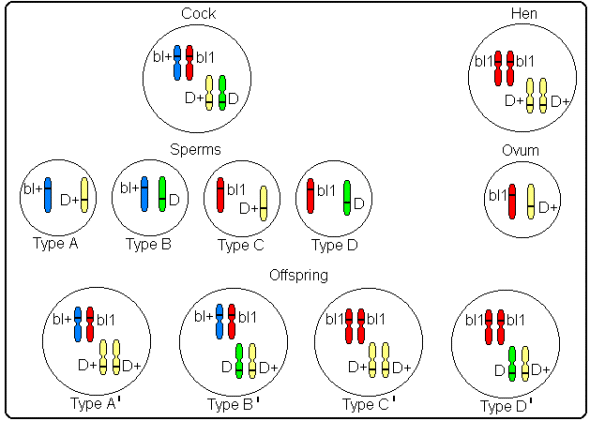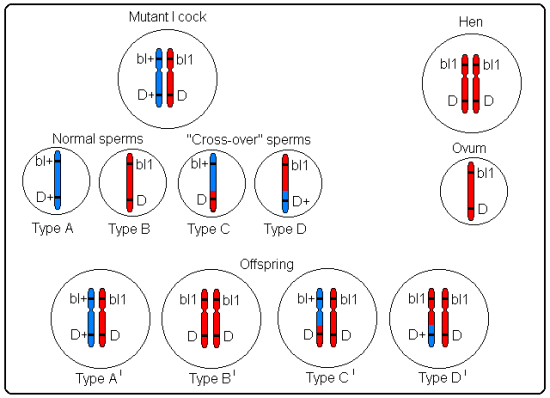|
Until now, we have assumed that genes for different traits are carried on different chromosome pairs. If this were always true, a cobalt cock (bl1bl1, D+D), for instance, would produce the same proportion of four different types pf sperms: 25% (bl+, D+); 25% (bl+, D); 25% (bl1, D+) and 25% (bl1, D). A sky blue hen (bl1bl1, D+D+), being homozygous for both loci can only produce one type of ovum, (bl1, D+). The matting of these two birds would then be expected to produce 25% light green chicks (bl+ bl1, D+D+); 25% dark green chicks (bl+ bl1, D+D); 25% sky blue chicks (bl1 bl1, D+D+) and 25% cobalt chicks (bl1 bl1, D+D).

Figure 5 – Hypothetical independent segregation of genes.
Breeders have discovered that when putting together these two types of birds, the four expected phenotypes do, indeed, appear on the offspring but not accordingly to the expected proportions. Sometimes dark greens and cobalts are born in greater numbers while light greens and sky blues appear to be the exception. Other times the reverse happens, dark greens and cobalts are the exception while light greens and sky blues are the majority.
What, in fact, occurs is that the locus for yellow pigment production and the locus for the dark factor coexist on the same chromosome.
When the production of sperms takes place, the gene for yellow pigment production and the dark factor on the same chromosome travel together. If the wild-type genes, bl+ and D+ travel together on the same chromosome, than the mutant genes, bl1 and D travel together on the other chromosome. This corresponds to a type I mutant (or mutant I). If, on the other hand, each chromosome has one wild-type gene and one mutant gene, that is, bl+ and D on one chromosome and bl1 and D+ on the other chromosome, them the bird is a type II mutant (or mutant II).
Because of this kind of linkage between genes on the same chromosome, cock birds produce a larger quantity of two kinds of sperms. A mutant I produces (bl+, D+) and (bl1, D) sperms, that when combined with (bl1, D+) ova originate respectively light green and cobalt chicks. A mutant II produces (bl+, D) and (bl1, D+) sperms that when combined with (bl1, D+) ova originate dark green and sky blue chicks.
However, both types of cobalt (mutant I and mutant II), when paired to a sky blue hen are capable of producing four different types of chicks, even if on different proportions. The explanation for the

|
unbalance between different phenotypes is a process called crossing-over. During the formation of sperms and ova, there is a period when the parental pairs of
|
chromosomes remain parallel to each other, linked gene by gene on certain positions of their length. During this period pairs of chromosomes are capable of exchanging equivalent segments of genetic material. When this happens, genes for the same trait located on the exchanged segments, travel from one chromosome to the other.
The further away two different genes are, on the same chromosome, the more likely it is that crossing-over will separate them.
On mutant I and mutant II, the phenotypes that appear on greater numbers are produced by "normal" sperms where crossing-over did not occur or where crossing over occurred on a length that did not separate the locus for yellow pigment production from the locus for the dark factor. The phenotypes that occur on smaller numbers are the ones originated from "cross-over" sperms.

Figure 7 – Offspring generated from normal sperms and "cross-over" sperms.
|





![]()
![]()
![]()
![]()
![]()